Birds
Birds are vertebrates that possess wings and feathers. Only birds have feathers. Feathers perform several functions: allow for flight, provide insulation, and combine with oils to shed water for waterproofing. The colors and patterns of feathers are important in camouflage, territorial displays, and sex attraction. Bird bones are thin and hollow to reduce their weight. Birds are endotherms in that they maintain a constant body temperature.
Featured Birds: American Robin, Mockingbird, Black-and-white Warbler, Blue Jay, American Crow, Mourning Dove, Eastern Phoebe, Red-shouldered Hawk, Great Blue Heron, Mallard, Whip-poor-will, Green Heron
Common Birds of Tumbling Creek Woods
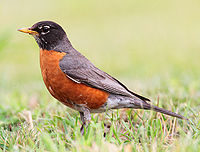 American Robin Turdus mibratorius Hunts in fields for insects and earthworms. Song sounds like "cheerily cheer-up cheerio." Open woodlands and fields. |
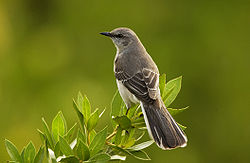 Mockingbird Mimus polyglottus Mimics the songs of other birds. Sometimes sings for a long time, even at night. Builds nests near ground and attacks anything near it. Highly territorial. Eats insects and fruits. Brushy fields. |
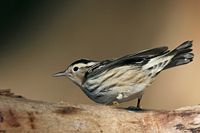 Black-and-white Warbler Mniotilta varia Feeds on insects by foraging on trunks of trees. Migrant. Mainly mature hardwood forests. |
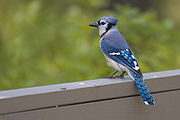 Blue Jay Cyanocitta cristata Feeds on insects, seeds, bird eggs, and acorns. Jays squawk loudly to ward off crows, hawks, cats, and owls. Woodlands. |
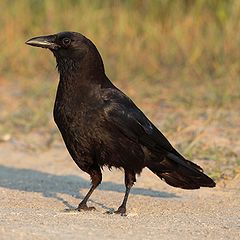 American Crow Corvus brachyrhnchos Feeds on variety of animals and plants, carrion. Highly intelligent. Communal roosts called rookeries. Nests made of sticks. Crows gather in flocks. Open habitats from fields to woodlands. |
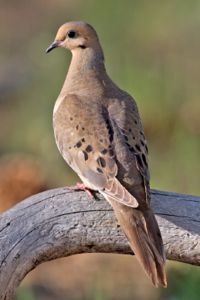 Mourning Dove Zenaida macroura Make cooing sound. Usually found in small groups. Often nest high in pine trees. Eat mostly seeds. Doves are game birds that can be hunted for sport. Fields and brushy areas. |
 Eastern Phoebe Sayornis phoebe Often nests on bridges and buildings. Often found near streams. Eats mainly flying insects. Sometimes called a "flycatcher." Song sounds like "fee-bee." Open woods and woodland edges. |
 Red-shouldered Hawk Buteo lineatus Nests in tall trees. Feeds on birds, rabbits, mice, grasshoppers, snakes, lizards, frogs. Mature forests near clearings and water. |
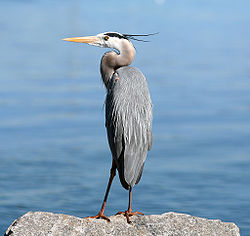 Great Blue Heron Ardea herodias Forages in streams, ponds, wet meadows and upland fields. Eats fish, small mammals, insects. Spears fish with bill. Nest of sticks in dead trees near wetland area. Heron that is often seen in inland areas around streams and ponds. |
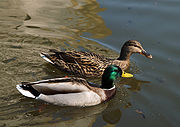 Mallard Anas platyrhynchos Nests hidden on ground within vegetation, usually near water. Feeds mainly on seeds. Shallow water habitats. Common in city and farm ponds. |
 Whip-poor-will Caprimulgus vociferus Nocturnal. Eats flying insects. Songs sounds like "whip poor weew." Nests on ground in open mixed pine and hardwood forests. |
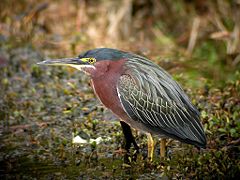 Green Heron Butorides virescens Nests in trees. Eats fish that it spears with its bill. Found along edges of streams and ponds. |
Birds of the Southeast
The birds listed below are common to fairly common visitors to our area. Each bird is linked to a web site administered by Cornell Lab of Ornithology where detailed information about the bird can be found. Images from Cornell Labs. The following information is available for each of the birds listed: Description, Sound, Conservation Status, Other Names, Cool Facts, and Full Detailed Species Account (range, habitat, food, behavior, reproduction).
Thrushes
|
Eastern Bluebird American Robin |
Hermit Thrush | Wood Thrush |
Mockingbirds, Thrashers
| Gray Catbird | Northern Mockingbird | Brown Thrasher |
Waxwings
| Cedar Waxwing |
Warblers
|
Northern Parula Yellow-rumped Warbler Black-and-white Warbler Common Yellowthroat |
Chestnut-sided Warbler Black-throated Green American Redstart Hooded Warbler |
Magnolia Warbler Pine Warbler Ovenbird |
Tanagers
| Summer Tanager | Scarlet Tanager |
Emberizids
|
Eastern Towhee White-throated Sparrow |
Field Sparrow Dark-eyed Junco |
Song Sparrow |
Cardinals, Grossbeaks
| Northern Cardinal | Rose-breasted Grosbeak | Indigo Bunting |
Blackbirds, Orioles
| Red-winged Blackbird | Common Grackle |
Finches
| House Finch | American Goldfinch |
New World Vultures
| Black Vulture | Turkey Vulture |
Ducks, Geese
| Canada Goose | Wood Duck | Mallard |
Hawks, Kites, Eagles
| Red-shouldered Hawk |
Pigeons, Doves
| Mourning Dove |
Swifts
| Chimney Swift |
Hummingbirds
| Ruby-throated Hummingbird |
Woodpeckers
| Red-bellied Woodpecker | Downy Woodpecker | Northern Flicker |
Tyrant Flycatchers
| Eastern Wood-Pewee | Eastern Phoebe |
Vireos
| White-eyed Vireo | Yellow-throated Vireo | Red-eyed Vireo |
Crows, Jays
| Blue Jay | American Crow |
Chickadees, Titmice
| Carolina Chickadee | Tufted Titmouse |
Nuthatches
| White-breasted Nuthatch | Brown-headed Nuthatch |
Wrens
| Carolina Wren |
Gnatcatchers
| Blue-gray Gnatcatcher |
